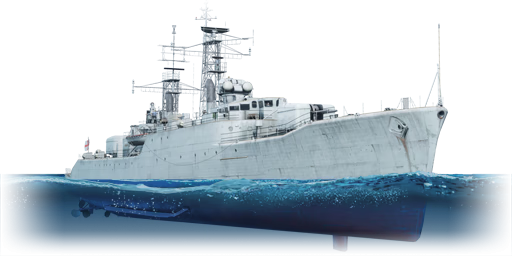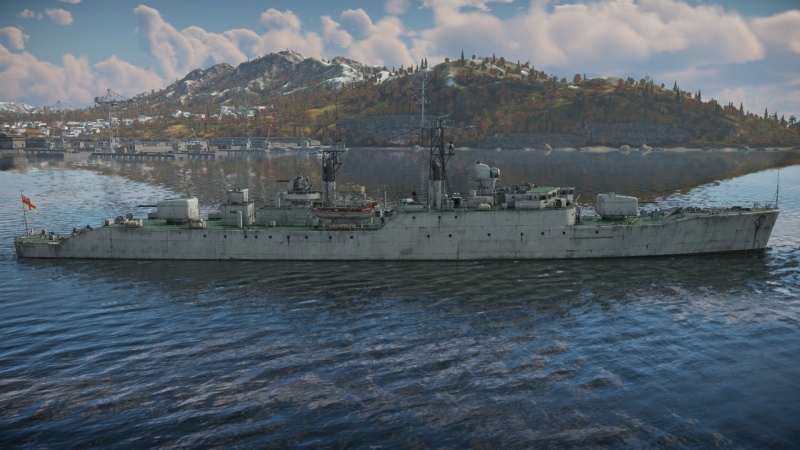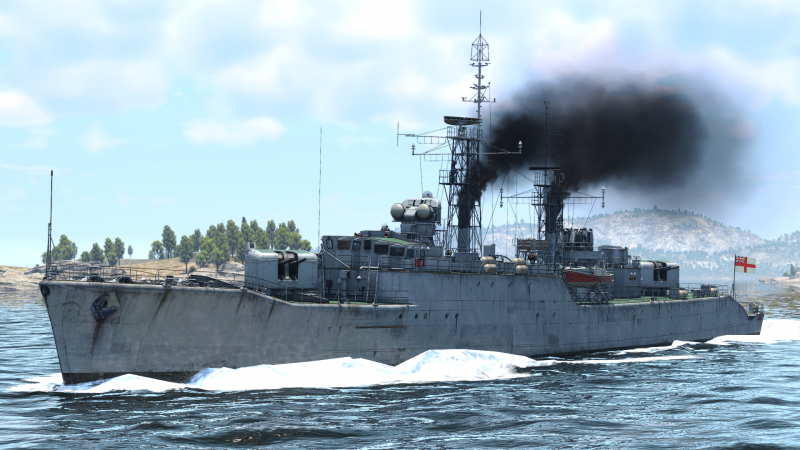Difference between revisions of "HMS Leopard"
Colok76286 (talk | contribs) (Corrected About template) |
Inceptor57 (talk | contribs) (Reverted pending rewrite) |
| (One intermediate revision by one other user not shown) | |
(No difference)
| |
Latest revision as of 04:43, 24 March 2024
| This page is about the British frigate HMS Leopard. For other uses, see Leopard (Disambiguation). |
Contents
Description
The Leopard-class, HMS Leopard (F14) is a rank V British frigate with a battle rating of 4.0 (AB/RB/SB). It was introduced in Update "Red Skies".
General info
Survivability and armour
Talk about the vehicle's armour. Note the most well-defended and most vulnerable zones, e.g. the ammo magazine. Evaluate the composition of components and assemblies responsible for movement and manoeuvrability. Evaluate the survivability of the primary and secondary armaments separately. Don't forget to mention the size of the crew, which plays an important role in fleet mechanics. Save tips on preserving survivability for the "Usage in battles" section. If necessary, use a graphical template to show the most well-protected or most vulnerable points in the armour.
Mobility
Write about the ship's mobility. Evaluate its power and manoeuvrability, rudder rerouting speed, stopping speed at full tilt, with its maximum forward and reverse speed.
| Mobility Characteristics | |||
|---|---|---|---|
| Game Mode | Upgrade Status | Maximum Speed (km/h) | |
| Forward | Reverse | ||
| AB | |||
| Upgraded | 62 | 20 | |
| RB/SB | |||
| Upgraded | 44 | 14 | |
Modifications and economy
Armament
Primary armament
Provide information about the characteristics of the primary armament. Evaluate their efficacy in battle based on their reload speed, ballistics and the capacity of their shells. Add a link to the main article about the weapon: {{main|Weapon name (calibre)}}. Broadly describe the ammunition available for the primary armament, and provide recommendations on how to use it and which ammunition to choose.
| Penetration statistics | |||||||
|---|---|---|---|---|---|---|---|
| Ammunition | Type of warhead |
Penetration @ 0° Angle of Attack (mm) | |||||
| 1,000 m | 2,500 m | 5,000 m | 7,500 m | 10,000 m | 15,000 m | ||
| 4.5 inch HE | HE | 28 | 28 | 28 | 28 | 28 | 28 |
| 4.5 inch SAP | SAP | 117 | 100 | 77 | 61 | 50 | 41 |
| 4.5 inch HE-TF | HE-TF | 28 | 28 | 28 | 28 | 28 | 28 |
| 4.5 inch HE-VT | HE-VT | 28 | 28 | 28 | 28 | 28 | 28 |
| Shell details | ||||||||||||
|---|---|---|---|---|---|---|---|---|---|---|---|---|
| Ammunition | Type of warhead |
Velocity (m/s) |
Projectile mass (kg) |
Fuse delay (s) |
Fuse sensitivity (mm) |
Explosive mass (TNT equivalent) (g) |
Ricochet | |||||
| 0% | 50% | 100% | ||||||||||
| 4.5 inch HE | HE | 746 | 24.95 | 0 | 0.1 | 2,320 | 79° | 80° | 81° | |||
| 4.5 inch SAP | SAP | 746 | 23 | 0.015 | 5 | 910 | 47° | 60° | 65° | |||
| 4.5 inch HE-TF | HE-TF | 746 | 24.95 | 0 | 0.1 | 2,320 | 79° | 80° | 81° | |||
| Proximity-fused shell details | ||||||||||||
|---|---|---|---|---|---|---|---|---|---|---|---|---|
| Ammunition | Type of warhead |
Velocity (m/s) |
Projectile mass (kg) |
Fuse delay (m) |
Fuse sensitivity (mm) |
Arming distance (m) |
Trigger radius (m) |
Explosive mass (TNT equivalent) (g) |
Ricochet | |||
| 0% | 50% | 100% | ||||||||||
| 4.5 inch HE-VT | HE-VT | 746 | 24.95 | 0 | 0.1 | 244 | 23 | 2,320 | 79° | 80° | 81° | |
Secondary armament
Some ships are fitted with weapons of various calibres. Secondary armaments are defined as weapons chosen with the control Select secondary weapon. Evaluate the secondary armaments and give advice on how to use them. Describe the ammunition available for the secondary armament. Provide recommendations on how to use them and which ammunition to choose. Remember that any anti-air armament, even heavy calibre weapons, belong in the next section. If there is no secondary armament, remove this section.
- Universal: AP-T · HEFI-T
- 40 mm HE clips: HEFI-T · HEFI-T · HEFI-T · AP-T
- 40 mm AP clips: AP-T · AP-T · AP-T · HEFI-T
| Penetration statistics | |||||||
|---|---|---|---|---|---|---|---|
| Ammunition | Penetration @ 0° Angle of Attack (mm) | ||||||
| 10 m | 100 m | 500 m | 1,000 m | 1,500 m | 2,000 m | ||
| HEFI-T | 3 | 3 | 3 | 3 | 3 | 3 | |
| AP-T | 81 | 78 | 68 | 58 | 49 | 41 | |
| Shell details | ||||||||||||
|---|---|---|---|---|---|---|---|---|---|---|---|---|
| Ammunition | Velocity (m/s) |
Projectile mass (kg) |
Fuse delay (m) |
Fuse sensitivity (mm) |
Explosive mass (TNT equivalent) (g) |
Ricochet | ||||||
| 0% | 50% | 100% | ||||||||||
| HEFI-T | 874 | 0.9 | 0 | 0.1 | 67.13 | 79° | 80° | 81° | ||||
| AP-T | 874 | 0.89 | - | - | - | 47° | 60° | 65° | ||||
Usage in battles
Describe the technique of using this ship, the characteristics of her use in a team and tips on strategy. Abstain from writing an entire guide – don't try to provide a single point of view, but give the reader food for thought. Talk about the most dangerous opponents for this vehicle and provide recommendations on fighting them. If necessary, note the specifics of playing with this vehicle in various modes (AB, RB, SB).
Pros and cons
Pros:
- Two QF 4.5in cannons, located at the aft and bow of the ship
- Raised QF STAAG AA mount near the center of the boat
- Bridge is hidden behind the bow's cannon
- Access to HE-VT shells
- Large crew complement
- Eight (separate) engine blocks, allowing for lasting mobility in combat scenarios.
Cons:
- Poor max speed compared to frigate's cousin, HMS Blackpool
- No torpedoes or other specialised high-explosives
- Ammunition for the STAAG and aft cannon are located in close proximity to each other
History
HMS Leopard was the lead ship of the Type 41 anti-air frigates. The concept of this frigate began in 1944 when the Royal Navy sought a new anti-submarine frigate. Original requirements asked for a mass-producible frigate with enough speed (around 25 knots) to chase surfaced U-boats and sufficient main gun firepower to engage them[1].
By 1945, the design concept witnessed significant changes due to the new threats and additional requirements. The new U-boat, Type XXI, could reach 15-18 kn submerged for an extended period, leaving the existing frigates (their speed was no more than 20 kn) or other escorts obsolete. Furthermore, the new enemy, the Soviet Union, who had paid a lot of attention to submarine warfare, would inevitably develop fast submarines. On the other hand, the Director of Anti-Submarine Warfare suggested to implement alternative Anti-Submarine Warfare (ASW) and Anti-Aircraft Warfare (AAW) armaments on the same hull as the previous 'Loch' and 'Bay' classes. The AAW type could provide air defense for the convoy and assist anti-submarine missions with a basic anti-submarine weapon such as depth charges. Besides, an Aircraft Direction (AD) type was added to guide land-based aircraft and provide early air warning for the convoy[2].
Further design modifications were included in the post-war era. In 1946, the British observed the Bikini nuclear test, demonstrating that the open deck seemed vulnerable against the atomic explosion. Thus, the new frigate design featured an enclosed bridge with minimized altitude and integrated all operations rooms (compass deck, radar room, etc.) within the enclosed structure. Debates on powerplant of different variants continued into the late 1940s. Finally, in 1947, it was decided that the AAW and AD types would use diesel machinery to achieve an endurance of 4,500 miles at 15 kn[3], while the ASW type would be equipped with new steam turbines to reach 27 kn for hunting down the Soviet equivalent of the Type XXI. In 1948, one AAW prototype (Leopard) and one AD prototype (Salisbury) were ordered, and the final design was approved by the Board in 1950[4]. This series of ships were marked as the 1951 Frigate Programme with Type 12 as ASW version, Type 41 as AAW type, and Type 61 as AD variant.
The AAW type shares the same all-welded[5] hull (340ft length, 40ft beam, 16ft draught) and machinery (8 Admiralty Standard Range diesel engines) as the AD type and differs in armament and equipment. Type 41 mounted two twin 4.5-inch dual-purpose guns, while Type 61 has only one mount. Both ships are equipped with completed radar systems, including Type 275 anti-air fire control and Type 960 air-warning radar. Compared to Type 61, Type 41 also mounted Type 262 close range anti-air control system and the Type 992Q surface/low-level search system for engaging aircraft[6]. That extra equipment and firepower caused the Type 41 to displace 1,835 tons, about a hundred tons heavier than Type 61 (1738 tons) [7]. The early number requirement for Type 41 was 11 in 1953, but eventually, only four ships were produced for the Royal Navy.
HMS Leopard was laid down at Portsmouth dockyard on 25 March 1953 and was launched on 23 May 1955[8]. She and her sister ships formed the 7th Frigate Squadron to show the flag at the South American station during peacetime. On 29 July 1963, Leopard was involved in a collision with South African minesweeper Pietermaritzburg during training exercise Capex 63, sending the ship back to Portsmouth for repairs[9]. Between October 1964 and February 1966, Leopard received a major refit to install new Type 965 and Type 993 radars with other ECM and ECCM equipment. In 1973, Leopard was deployed to support European trawlers in Britain's fishing dispute (or second 'Cod War') with Iceland. She was involved in a close confrontation with patrol ship Ægir but did not open fire. She also conducted another patrol in supporting British trawlers during a fishing dispute in 1975.
In the 1970s, the lack of missile armament made the Type 41 frigate obsolescent in modern warfare. However, a large-scale modernization of weapons was impracticable for economic reasons, as well as the ships' deteriorating condition[5]. Therefore, these frigates were either retired or sold to other countries in the late 1970s. In 1977, Leopard was sold for scrap at Dartford[7].
Media
- Skins
See also
Links to articles on the War Thunder Wiki that you think will be useful for the reader, for example:
- reference to the series of the ship;
- links to approximate analogues of other nations and research trees.
External links
References
- ↑ Brown, David K.; Moore, George. Rebuilding the Royal Navy: Warship Design Since 1945 (p. 171). Pen & Sword Books.
- ↑ Friedman, Norman. British Destroyers & Frigates (Kindle Location 7232). Pen and Sword. Kindle Edition.
- ↑ Brown, David K.; Moore, George. Rebuilding the Royal Navy: Warship Design Since 1945 (p. 173). Pen & Sword Books.
- ↑ Friedman, Norman. British Destroyers & Frigates (Kindle Location 7490). Pen and Sword.
- ↑ 5.0 5.1 Marriott, Leo. Royal Navy Frigates 1945-1983 (p.45). London IAN ALLAN LTD.
- ↑ Marriott, Leo. Royal Navy Frigates 1945-1983 (p.51). London IAN ALLAN LTD.
- ↑ 7.0 7.1 Brown, David K.; Moore, George. Rebuilding the Royal Navy: Warship Design Since 1945 (p. 174). Pen & Sword Books.
- ↑ Warlow, Ben; Colledge, J J. Ships of the Royal Navy (p. 530). Pen and Sword.
- ↑ Arikin, William M.; Handler, Joshua. Naval Accidents 1945 – 1988 (p. 31). Neptune Papers No. 3.
| Portsmouth Royal Dockyard | |
|---|---|
| Frigates | |
| Leopard-class | HMS Leopard |
| Heavy Cruisers | |
| County-class | HMS London |
| Battleships | |
| Unique ships | HMS Dreadnought |
| Orion-class | HMS Orion |
| Iron Duke-class | HMS Iron Duke |
| Britain frigates | |
|---|---|
| Leopard-class | HMS Leopard |
| Whitby-class | HMS Blackpool · HMS Whitby |
| Restigouche-class | HMCS Terra Nova |






